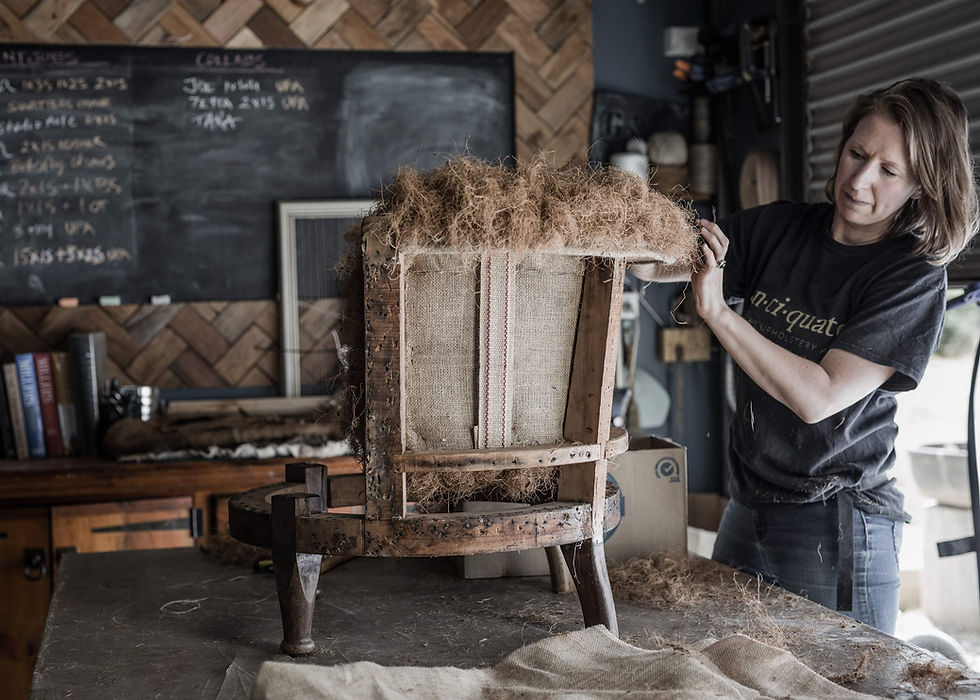5 Top Tips for DIY Upholsterers
- Kerri
- Oct 23, 2020
- 3 min read

Starting a DIY upholstery adventure is not only a lot of fun but very rewarding. There is something special about understanding how things are made, and walking into your lounge seeing a beauty you have restored is always a heart bursting moment.
Learning a new skill like upholstery is great, but where do you start?
Heres my top tips to get you started on your DIY upholstery practice.
Know the type of upholstery you wish to learn
Just like many trades, there is a modern way and traditional way. It doesn’t mean one is right and the other is wrong. It means that with the evolution of materials, resources and education, there has been modifications to keep up with this fast paced world.
Knowing the key differences between modern and traditional upholstery will help you determine the information you need to gather for your new creative outlet.
Traditional upholstery: An age old craft using hand tools, slow techniques and much precision. Natural materials are used throughout the rebuild making it a MUCH more environmentally friendly option. Timely? Yes, absolutely. But worth every moment you put into the craft.
Modern upholstery: The modernised approach to upholstery uses foams and synthetic fibres to keep the cost and time down significantly.
2. Pick a simple piece to start on
It is always so frustrating when you see a gorgeously disheveled old wingback or chaise lounge that you can feel deep in your bones that you would be able to fix up... then someone (like me) comes along and says start small, start basic.
I get it. I really do. It’s those amazing (yet complex) pieces that bring a swoosh of inspiration and determination to make it the stand out feature of your room. Starting basic isn’t always as inspiring, but trust me, its worth it. Dining chairs or Bridge chairs are perfect to start your upholstery quest. Take your time on these ‘practise pieces’ and you’ll be restoring bigger pieces in no time.
3. Resources
Oh the resources!! There is SO many these days, but that can quite often make things a little more confusing If you’re not sure what you are looking for. If you took the time to do step 1 of this post, it makes things a little easier, as you’ll be able to quickly recognise what content is not for you.
YouTube, Books, blogs, upholstery FB groups, online workshops, in person workshops, your community - There are resources everywhere. Start asking around your community, you never know who has a retired upholsterer family friend that would love to teach another generation. That’s how I started, and it turned into the most beautiful mentorship and friendship.
If you’re interested in my online workshop click HERE, if you’re after in person workshops I can point you in the right direction also.
4. Learn your materials
A lot of upholstery materials have many functions and many upholstery techniques can be done with numerous materials. It sounds confusing but once you get a handle on the basics, it will be much easier to learn the skills that go along with it.
Start by researching coconut fibre, types of springs, hessian, cotton lintas, flock, dacron, calico, twines used, and foam densities. This will set you up for an easier learning process. Online and in person workshops would naturally cover this type of information.
5. Take your time!
The more particular you are about your finishes throughout the process, the better the overall finish will be. See each step as an important and necessary stage to create comfort and beauty individually. Give that one step all the time and attention it needs before looking at the next step. Your future self will thank you!
Upholstery is such a wonderful and satisfying practise. I wholeheartedly encourage anyone who is intrigued by it to give it a go. I started out intrigued, and now I have a business that I absolutely adore.
If you’d like a little more assistance navigating your first few pieces, check out my online Upholstery 101 course.






Comments